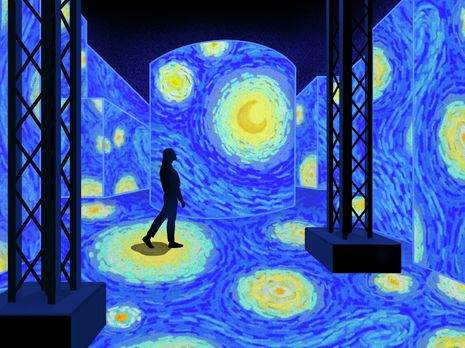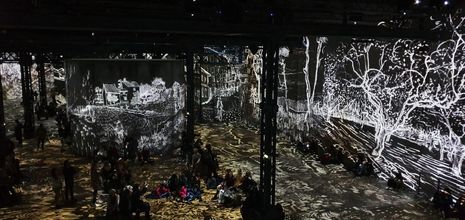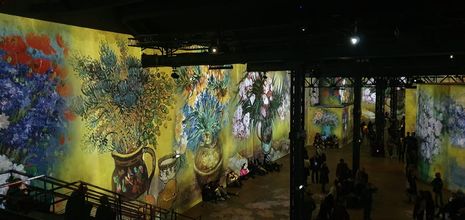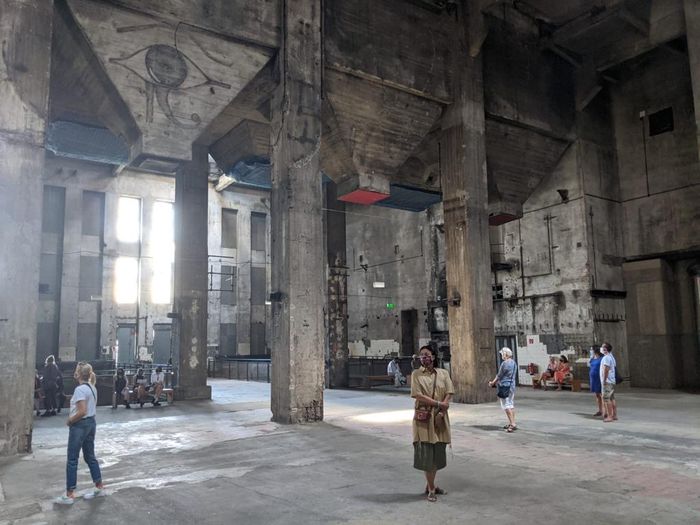Immersive light exhibitions: the future of gallery experiences?
Zoe Swanwick looks back at her recent experiences in French exhibitions to find the future of the gallery experience

Imagine you’re walking into a large room. It’s dark and quiet. Then, all of a sudden, colours and music ambush the scene. Paintings are projected onto the walls, the ceiling and the floor, in constant movement, not letting your eyes settle for even one instant on one definitive shape. The music is intense. Awe-struck you look around, attempting the best you can to absorb all the new sensations. This is how it felt to walk in to L’atelier des Lumières — a gallery space offering a whole new kind of experience to enjoy art.

Since 2018, the French company, Culturespaces Digital has been creating and developing digital art centres with digital exhibitions in a complete shake-up of the traditional gallery viewing. It is the first company to combine digital design, animation and gallery curations in order to present the works of classical, modern and contemporary artists. Having been able to visit two such centres, the first an old warehouse in Paris and the second in a submarine base in Bordeaux, I am still astounded by both experiences. For me, the creative mastery behind the Van Gogh exhibition in Paris best showcased the exciting potential that new technology brings to the cultural space. The use of light projections brilliantly highlighted Van Gogh’s expressive brushstrokes and enhanced the bold colours present in his work, and was quite a contrast to the (rarely-admitted-to) boredom often found in large gallery and museum spaces.
“These extremely immersive light experiences allow for a new way to appreciate art and transform gallery viewings”
That said, there can be something quietly pleasant about wandering through wide, white corridors showcasing canvassed squares of creativity and imagination. Such places can offer moments of peaceful contemplation. L’Orangerie, situated next to the Louvre in Paris, is one of these places that holds the viewer in suspension, worlds away from one of the busiest and most exhausting cities in the world. It offers the viewer a pause in a place usually dominated by the rush of the city. In other bigger galleries, such as the Louvre or the Tate Modern, it is impossible to study each work with the attention they perhaps deserve, but maybe that doesn’t matter: it is an invitation to go back and to look at different pieces each time. Here, I think we see both the downfall and advantage of such all-consuming light exhibitions. They are fully immersive experiences designed to overwhelm every one of your senses. Dramatic, powerful and awe-inspiring, it is not the usual environment of quiet contemplation that we are used to in the traditional gallery.
In the face of such large explosions of light and music it is difficult not to be overpowered by the multi-sensorial experience. It seems that the traditional gallery is no longer enough to satisfy the increasing cultural thirst of its visitors. Do light exhibitions, such as the ones presented by Culturespaces Digital, reflect the consumerist attitude of a society always wanting more? Perhaps it is symptomatic of our supposedly ever-shortening attention span, much like the 12 minute YouTube video or each gratifying click of the ‘like’ button. In this context, the endless stream of stimulus is both overwhelming and pleasing to the senses. Little interpretive work is required from the audience. The dangers of the over-stimulating effects of technology and of the internet and social media has been explored by many, and continues to be a source of worry for those who link it to laziness and an increasing dependence on technology as a source of constant distraction.
“The careful curation of art and music allows for new associations to be made between images and ideas”

The link made between impulsivity and immediacy that concerns some is certainly a theme that can be identified in these dramatic light experiences, but we shouldn’t be so quick to pass judgement on the lack of space for slow contemplation. The careful curation of art and music allows for new associations to be made between images and ideas. By offering an animated homage to the work of traditional artists, directors Gianfranco Iannuzzi, Renato Gatto, and Massimiliano Siccardi create a whole new work of art, with the potential to transform the cultural landscape. I say potential because I believe we are only at the beginning what could be a revolution in art. Despite the use of avant-garde techniques, the biggest exhibitions created thus far rest on reinventing the works of now-canonical artists: Gustave Klimt, Van Gogh, Paul Klee, Monet, Renoir…. All were fantastic and revolutionary artists in their time (and ours) but nevertheless it limits the extent to which we can reimagine an art world already dominated by white men.
Despite visible limitations, these extremely immersive light experiences allow for a new way to appreciate art and transform gallery viewings, providing an exciting glimpse of how future cultural experiences may be formed. Given the strain currently put on cultural institutions by the pandemic, these kinds of light exhibitions show how artistic boundaries can be pushed through new technologies and encourage us to reconsider how we value and categorise art. Using time-honoured art and combining it with animated effects, light and music, a sense of the marvellous is offered to us. New art is created in front of our eyes.
 Features / Should I stay or should I go? Cambridge students and alumni reflect on how their memories stay with them15 December 2025
Features / Should I stay or should I go? Cambridge students and alumni reflect on how their memories stay with them15 December 2025 News / Cambridge study finds students learn better with notes than AI13 December 2025
News / Cambridge study finds students learn better with notes than AI13 December 2025 News / Uni Scout and Guide Club affirms trans inclusion 12 December 2025
News / Uni Scout and Guide Club affirms trans inclusion 12 December 2025 Comment / The magic of an eight-week term15 December 2025
Comment / The magic of an eight-week term15 December 2025 News / Cambridge Vet School gets lifeline year to stay accredited28 November 2025
News / Cambridge Vet School gets lifeline year to stay accredited28 November 2025









